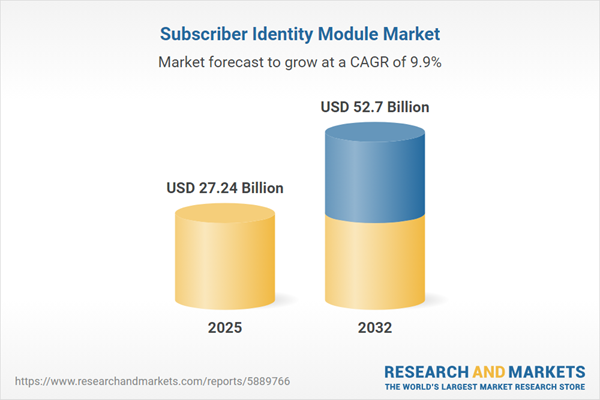Speak directly to the analyst to clarify any post sales queries you may have.
The Subscriber Identity Module market is undergoing a significant transformation as new technologies, regulatory changes, and evolving end-user needs continue to reshape the industry value chain. For senior decision-makers, understanding these multidimensional shifts is crucial to informed strategic planning and long-term competitiveness.
Market Snapshot: Global Subscriber Identity Module Market Growth
The Subscriber Identity Module market grew from USD 24.80 billion in 2024 to USD 27.24 billion in 2025. It is expected to continue expanding at a CAGR of 9.87%, reaching USD 52.70 billion by 2032. Momentum is being driven by escalating adoption of 5G networks, embedded SIM architectures, and growing IoT deployments. Major regions such as the Americas, Europe, Middle East & Africa, and Asia-Pacific continue to shape the competitive landscape and technological adoption patterns, with sector-wide shifts towards remote provisioning, resilient supply chains, and cloud-based management platforms.
Scope & Segmentation Analysis
This report provides a comprehensive overview of the Subscriber Identity Module ecosystem, mapping market trends, segment dynamics, and competitive positioning across key categories and regions.
- Card Type: Esim • Isim • Traditional Sim (Mff2, Micro Sim, Mini Sim, Nano Sim)
- Form Factor: Mff2 • Micro Sim • Mini Sim • Nano Sim
- End User: Automotive • Bfsi • Consumer • Government • Healthcare • Iot • Retail
- Technology Generation: Five G • Four G • Lte M • Nbiot • Two G and Three G
- Distribution Channel: Direct (Device Oem, Mno Partnerships) • Indirect (Distributor, Retailer)
- Geographies: Americas (North America: United States, Canada, Mexico; Latin America: Brazil, Argentina, Chile, Colombia, Peru) • Europe, Middle East & Africa (Europe: United Kingdom, Germany, France, Russia, Italy, Spain, Netherlands, Sweden, Poland, Switzerland; Middle East: United Arab Emirates, Saudi Arabia, Qatar, Turkey, Israel; Africa: South Africa, Nigeria, Egypt, Kenya) • Asia-Pacific (China, India, Japan, Australia, South Korea, Indonesia, Thailand, Malaysia, Singapore, Taiwan)
- Companies Profiled: Thales Group SA • IDEMIA Group • Giesecke+Devrient Mobile Security GmbH • Infineon Technologies AG • NXP Semiconductors N.V. • STMicroelectronics N.V. • Eastcompeace Technology Co., Ltd. • Watchdata Technologies Co., Ltd. • Beijing Goldpac Technology Co., Ltd. • Valid S.A.
Key Takeaways for Senior Decision-Makers
- Subscriber Identity Module technology is shifting from traditional physical cards to advanced embedded and integrated solutions, driving secure authentication for both consumer and industrial use cases.
- The rise of eSIM and iSIM enables remote provisioning and streamlined device onboarding, reducing traditional logistics challenges and fostering operational efficiency across diverse deployments.
- Collaboration between chipset vendors, network operators, and cloud service providers is fueling unified management platforms, essential for scaling IoT applications and ensuring reliable connectivity in critical sectors like automotive and healthcare.
- Security remains a core focus, with the integration of hardware-based trust mechanisms and lifecycle monitoring tailored to evolving regulatory expectations and increased cyber threat landscapes.
- Regional dynamics, such as supportive regulations in the Americas and EU, as well as local manufacturing strengths in Asia-Pacific, directly influence technology adoption and supply chain resilience.
- Industry leaders are prioritizing sustainability, reducing plastic use, and introducing circular economy practices to align with enterprise procurement requirements and environmental standards.
Tariff Impact and Global Supply Chains
Recent United States tariff adjustments have affected component costs and sourcing strategies for Subscriber Identity Module manufacturers. Companies are responding by diversifying procurement channels, investing in local assembly, and leveraging digital provisioning to reduce reliance on physical distribution. These changes encourage partnerships with regional supply chain actors and have accelerated the shift toward eSIM and iSIM uptake across a range of connected devices, effectively strengthening supply chain resilience in a shifting policy environment.
Methodology & Data Sources
This analysis is built on a foundation of primary interviews with executives across manufacturing, network operations, and IoT services, complemented by structured surveys, reviews of industry reports, regulatory documents, and case studies from relevant deployments. Findings undergo rigorous triangulation and cross-validation to ensure actionable insights and reliable outcomes for Subscriber Identity Module stakeholders.
Why This Report Matters
- Delivers segment-specific and regional intelligence, empowering strategic investment and market entry decisions.
- Supports risk mitigation and supply chain planning with insights on regulatory shifts and tariff impacts affecting sourcing and procurement.
- Guides technology adoption by detailing innovation and sustainability initiatives shaping the Subscriber Identity Module ecosystem.
Conclusion
The Subscriber Identity Module market is advancing rapidly, driven by interoperable solutions, secure provisioning, and sustainable practices. Leaders who leverage these trends and adapt to evolving dynamics will position their organizations for sustained success in the connected device space.
Additional Product Information:
- Purchase of this report includes 1 year online access with quarterly updates.
- This report can be updated on request. Please contact our Customer Experience team using the Ask a Question widget on our website.
Table of Contents
3. Executive Summary
4. Market Overview
7. Cumulative Impact of Artificial Intelligence 2025
Companies Mentioned
The companies profiled in this Subscriber Identity Module market report include:- Thales Group SA
- IDEMIA Group
- Giesecke+Devrient Mobile Security GmbH
- Infineon Technologies AG
- NXP Semiconductors N.V.
- STMicroelectronics N.V.
- Eastcompeace Technology Co., Ltd.
- Watchdata Technologies Co., Ltd.
- Beijing Goldpac Technology Co., Ltd.
- Valid S.A.
Table Information
| Report Attribute | Details |
|---|---|
| No. of Pages | 192 |
| Published | October 2025 |
| Forecast Period | 2025 - 2032 |
| Estimated Market Value ( USD | $ 27.24 Billion |
| Forecasted Market Value ( USD | $ 52.7 Billion |
| Compound Annual Growth Rate | 9.8% |
| Regions Covered | Global |
| No. of Companies Mentioned | 11 |









